Question: What do New Coke, texting your ex late at night, breakfast burritos at convenience stores, and real time feedback software for your team all have in common?
Answer: They all seemed like good ideas in the moment, but ultimately failed to work out as hoped.
While we can't help you with your regrettable dining decisions, or an ill-considered text, we can save you from getting on the disastrous hype train of "real time feedback."
What is real time feedback?
Real time feedback is where you use a system, like a mobile app, an email notification, or chat app to give written feedback to a coworker or team member right after an event, presentation, or meeting.
In theory, it should cause you and your coworkers to give more feedback, which then improves everyone. In practice, it creates more problems than it solves, if it gets used at all.
Today’s post covers why real time feedback is such a bad idea, and how we got here to think it might be a good idea.

How did we get here?
When a problem becomes big enough, it's often considered easier to throw it all away and start over than it is to try to fix it. Performance reviews is one such problem.
We've talked about why this is the case a number of times on the Lighthouse blog. Common issues of performance appraisals include:
- The toxic, damaging effect on culture from stack ranking team members.
- The inherent bias in evaluating other people's skills (62% of score variance is based on your own skill level).
- The incredible time spent by employees, managers, and HR. (Over 2 million hours in total and 30 hours per employee according to Deloitte's internal study)
And those are just the issues when managers actually put in a real, positive effort into writing their reviews. Additional damage is done when managers mail it in, rush through them, or play favorites.
With all this in mind, it's little surprise then that a recent study found:
"More than half (55 percent) of office workers and 66 percent of managers wish that their companies would get rid of or change the current performance review process."

The risk of throwing the baby out with the bathwater.
When you swing the pendulum completely in the other direction and throw the proverbial baby out with the bathwater, the correction can cause just as much damage as the original problem. The new, polar opposite solution may eliminate many of the problems it was set out to solve, but unfortunately creates many of its own.
This is where the fallacy of real time feedback comes in. If once or twice a year is not enough feedback, then why not swing the pendulum all the way to feedback all the time?
While it makes sense logically, it's proven to be just as much of a failed idea as New Coke and other "seemed like good ideas in the moment." Today, we break down the many reasons why. Here's what you'll read about today:
Table of Contents
- Why great leaders pause before giving feedback
- Why good feedback is a conversation, not a drive-by
- Building a completely new habit is very hard
- Data shows people want more feedback: monthly, not daily
- Real-time feedback can be affected by recency bias
- Managers need to focus on the big picture

5 Reasons Why Real Time Feedback is a Terrible Idea for Your Company (+ what to do instead)
The best way to avoid making a bad choice is to pause and look at the big picture. Often, when you zoom out and take a moment, what originally was a good idea no longer looks like one.
With this in mind, let's take a look at some of the many angles where real time feedback fails.
1) Great leaders pause before giving feedback.
If you consider only one reason for why real time feedback is a bad idea, this is it.
In principle, getting feedback right when something happens seems convenient and welcome, but it's a dangerous move.
In the moment, emotions can run high, and it's often difficult to think clearly. It's easy for the Elephant (our emotional mind) to get the best of the Rider (our weaker, smaller, rational mind), and not put our best foot forward. [Ed note: Learn more about the Elephant and the Rider here.]

Avoid regrets, or sticking your foot in your mouth.
Think about the last time you were upset, stressed, tired, or up late working. Was that the right time to send feedback to someone? Whether they "really needed to hear it" or not, you were probably not at your most constructive and effective in your feedback in that moment.
If you've ever written an angry email, and then saved it in drafts until the morning, you know how relieved you were you didn't push send. Meanwhile, when you have sent that message, you know how hard damage control was after that fact.

Learn from the Greatest.
Over and over, lessons from great leaders show how important it is to wait to give feedback. Dale Carnegie shares two such lessons from U.S. Presidents in his legendary leadership book, How to Win Friends and Influence People:
1) Abraham Lincoln's letters
A young Abraham Lincoln was notorious for writing harsh feedback to others. In one such case, he upset the person so much that they challenged him to a duel. The only thing that saved Lincoln from death or humiliation was a last minute intervention from a friend.
From that point forward, Lincoln resolved to stop giving his feedback so harshly, publicly, and quickly.
Even in difficult times during the Civil War, he would put harsh letters written to his losing generals in a drawer. This helped him avoid succumbing to the immediate gratification, but damaging effects, of giving feedback in the moment.
2) President Taft's skillful response
William Howard Taft, 27th President of the United States (and later Supreme Court Justice), was even more skillful than President Lincoln when it came to dealing with others.
In one such case retold by Dale Carnegie, Taft skillfully handled an overbearing mother trying to coerce a political appointment.
In Taft's own words:
"When you get a letter like that, the first thing you do is to think how you can be severe with a person who has committed an impropriety, or even been a little impertinent. Then you may compose an answer. Then if you are wise, you will put the letter in a drawer and lock the drawer.
Take it out in the course of two days...and when you take it out after that interval, you will not send it."
Taft knew that after waiting 2 days, his emotions would calm, and he could then write an entirely different letter, calmly and politely addressing the issue at hand. With his diplomatic skills and wisdom in waiting, he was able to handle the mother without upsetting her permanently or caving to her demands.
Learn from Lincoln and Taft; waiting when you need to give feedback ensures it is delivered well, and avoids the damage of a hasty, real time response.
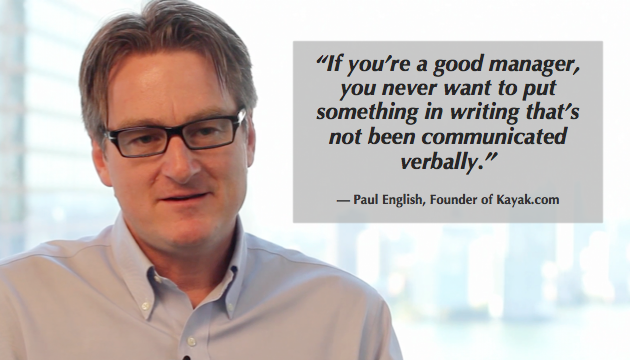
2) Good feedback is a conversation not a drive-by.
If you tell someone what they did wrong with just a sentence or two in an app, what do they really have? They don't know how big a deal it is, what to do about it, or have a chance to ask you clarifying questions.
There's only so much nuance you can convey in a few words. While you could write more, or chat back and forth, you're no longer talking about real-time feedback; at that point, you might as well have a real discussion about it.
When you send that quick feedback, the recipient is left stewing on it until the next time you can talk. Giving your people a week to worry about it and make up their own story in their head of what's going on is a recipe for unnecessary stress.

The very real damage of feedback.
Even if you talk in say a day or two, the damage from drive-by feedback is great. As a biochemist wrote on "The Neurochemistry of Positive Conversations" in the Harvard Business Review:
"When we face criticism, rejection or fear, when we feel marginalized or minimized, our bodies produce higher levels of cortisol, a hormone that shuts down the thinking center of our brains and activates conflict aversion and protection behaviors.
We become more reactive and sensitive. We often perceive even greater judgment and negativity than actually exists. And these effects can last for 26 hours or more... Cortisol functions like a sustained-release tablet – the more we ruminate about our fear, the longer the impact."
While you may have the best of intentions when you type in some real time feedback to your team, realize the damage you could be doing. Without the full context of your feedback and reassurance of your intentions, you could be causing additional stress, and fear in your team, affecting all their work.

Get all the context first.
Unless you are shadowing someone or pair programming 100% of your day, you do not know everything going on with someone. That moment you want to give feedback could very easily be the tip of the iceberg for a deeper, more important issue to address.
The worst thing you can do as a peer, or a manager, is kill your credibility with them by misinterpreting a situation. When you jump to give real time feedback that's exactly what you could be doing.
A story of critical context.
A mentor of mine once told a critical story of context to me. They had a team member that made a very poor hire that they had to deal with. After letting the underperformer go, they were tempted to immediately criticize the team member. They could see the team member did not follow their typical hiring process well, which had led to the poor hire.
It would have been so easy, and felt so good in the moment to criticize them harshly. Instead, they waited until their next 1 on 1 meeting later that week to talk about it. They were very glad they did.
In the meeting, they discovered that the team member felt severely over-extended, and this had led to the typical hiring process being shortcut. The team member already felt terrible about the hire, and apologized before my mentor could even bring it up. More importantly, together they focused the discussion on getting some responsibilities off their plate, which treated the root cause of the problem.
My mentor could have felt great in the moment criticizing them about the bad hiring, but that would have only made them feel worse. By waiting to have a real conversation, the feedback was effective, and left everyone feeling better afterwards.
3) Building a completely new habit is very hard.
In the always-on-the-go, tech in our pocket world, there are a million distractions. Constant push notifications pull us in a million directions. On top of this, at work, days are usually filled with meetings, and dozens, if not hundreds of emails.
Adding yet another, new habit, becomes harder and harder with each habit that is already competing for your attention. When those habits are not anchored to any existing need, and do not have a natural reward, it's difficult for them to stick.
You can't build a new habit without a hook.
Nir Eyal's Hook Canvas shows what it takes to build a new habit successfully:
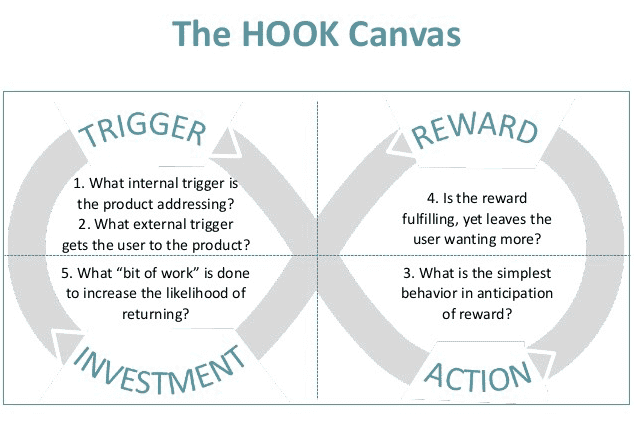
The problem with real time feedback is it breaks a number of the hook steps:
- Trigger - It's an entirely new behavior to be prompted to give feedback after every meeting or interaction with someone. You can send a notification, but it can be easily lost in the sea of reminders and notices while you run from meeting to meeting and task to task.
- Reward - As we discussed earlier, real time feedback can have exactly the wrong reward; you may feel great in the moment about telling someone critical feedback, but it can do more harm than good as time passes.
- Investment - Feedback can become a hollow act you feel worse about each time you give it. This is either because you were afraid to be candid, or regretful after having more time to reflect.
With all these issues, it's no surprise that in our discussions with people trying real time feedback, they've had a hard time getting them adopted. I spoke with a VP of HR at a 1,500 employee company earlier this month who tried a system, and the percentage of employees in the pilot engaging with the system was in the single digits.
Building any new habit is hard, and you have to ask yourself: is this a habit you want your team members to build?
4) Data shows people want more feedback: monthly, not daily.
There are a number of studies out that clearly show that people want feedback more than once or twice a year. That's great and makes sense. However, it's flawed to think that it absolutely means that you should go all the way to the other extreme and give feedback all the time.
Too much feedback can have painful effects.
In the show Black Mirror, the impact of technology and social situations are taken to extreme cases. In the opening episode of Season 3, they look at what happens if we all were constantly rated and given feedback.

Lacie is trapped in a world where everyone is always fake and afraid of making a mistake. They're always forcing smiles and pushing through awkward situations to get that 5 star rating.
The results of this world were as you might imagine. Lacie fell into the depths of despair as every aspect of her life, and especially mistakes, were under a public microscope. It's not a world any of us would want to live in.
Constant, instant feedback can smother innovation. If you want your team to take risks and be willing to be candid, you can't have them fearing feedback on every little thing they ever say.
Give people the amount of feedback they really want.
Yes, people of all generations are saying they want more feedback than a once or twice a year review. However, even for Millennials, feedback is really desired a lot less than real time feedback would suggest.
In a study by Success Factors, they found a striking result for how often people want feedback:
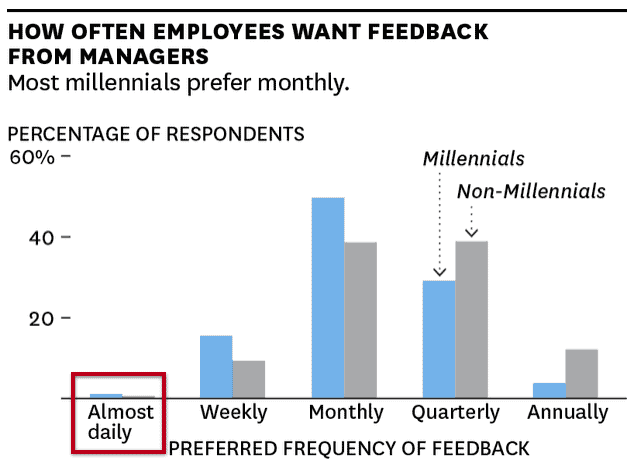
Notice that while Millennials do want more feedback than their peers, it's mostly weekly or monthly.
Meanwhile, the percent of people of any generation that would like feedback "Almost daily" is almost no one. There's actually more people that would like to stick to annual feedback.
Don't let the tyranny of a minority of vocal supporters convince you otherwise. Keep your teams candid and innovative by providing feedback regularly, but not real time.
5) Real-time feedback can be affected by recency bias
Recency bias is defined as the tendency to use our most recent memories when evaluating things. That can happen even if those memories are not the most relevant or reliable.
Recency bias is part of human nature - it’s why lawyers put so much emphasis on their closing argument or why people are more afraid of sharks after a shark attack (even though they are extremely rare).
In the case of real-time feedback, the message you deliver to your team member can be skewed by your most recent impression of them. For example, a mistake they made that’s fresh in your memory could make your feedback harsher than it needs to be.
And if you forget some of the good work they’ve done in the past, that can even make you seem unfair in their eyes.
Give feedback based on everything they’ve done, not just the last meeting or incident
It’d be a mistake to form an opinion about a team member based on a fleeting impression. Yet, if you’re filling out a quick form about a meeting that just happened, you’re going off of only your thoughts in that moment. How good can your feedback really be at that point? And how does your team member know the difference between a minor or major thing? As we talked about earlier, there’s no nuance to your recency biased feedback.
Instead, you should look at the patterns in their behavior over a longer period of time and let that shape the feedback you give. The long term, repeated mistakes or issues are much more important than a one time slip.
To do that, you need to:
- Take notes of what you're talking about when you meet with them (their performance, behavior, reaction to your advice, etc.)
- Take time to review your notes before you give them feedback by reflecting on a series of presentations, meetings, or events, instead of one-off in the moment.
The more influenced you are by the few negative things they’ve done recently, the less relevant your feedback will be to them. This is why it’s critical to take notes of your meetings with them and regularly make time to look for the big picture, which happens to be our next reason:
6) Managers need to focus on the big picture.
If you want to help your people improve, the best thing you can do is focus on the highest impact areas. You can't improve everything at once.
Being critical or constructive about every little thing can distract them from this.
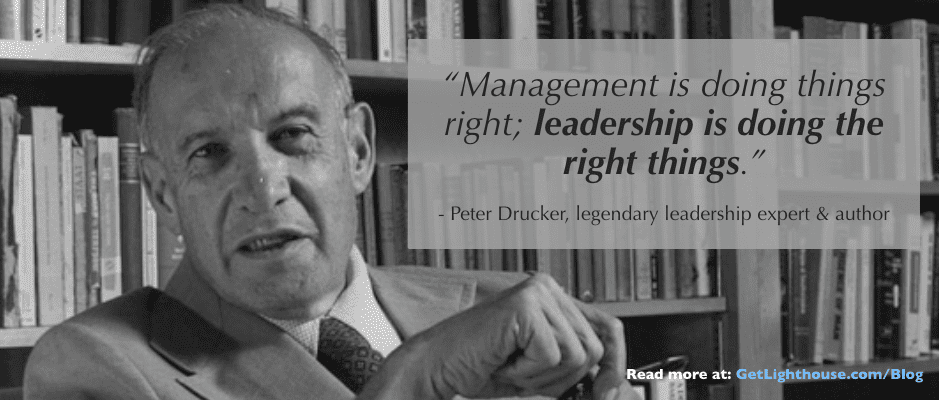
Is this the most important thing?
We all make mistakes every day. You could say "umm" too much in a presentation, poorly word a follow-up email, or forget to fully comment your code you submitted.
Any (or none) of those could be the most important thing for you to improve depending on the situation. However, if you were told about all of them in the same day, it would be hard to focus on fixing any of them consistently. There can only be one most important thing.
This is why legendary leadership coach and author Peter Drucker emphasizes the value of focus. Any leader, whether a manager or leading themselves needs to decide whether the feedback they want to give is truly important. As the old saying goes, "if everything is important, then nothing is."
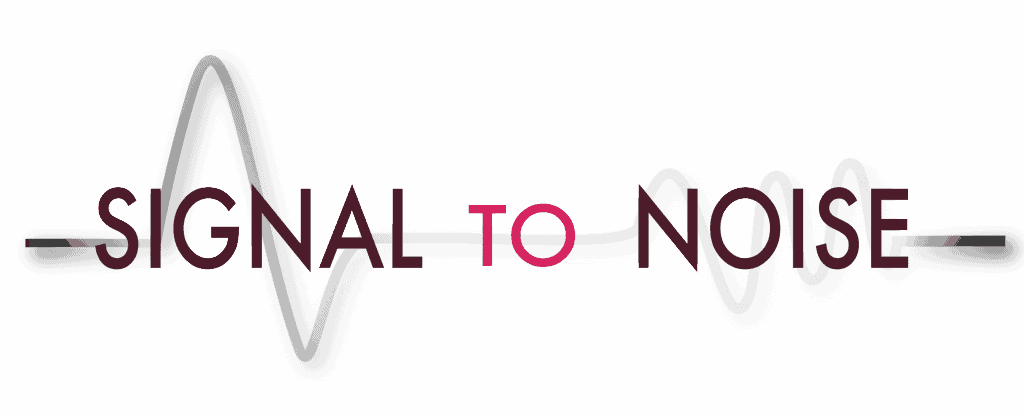
Get out of the noise, keep the signal.
One of the greatest benefits in pausing before giving feedback is to decide if it really matters. If it's part of a larger trend, it's well worth the discussion; you then have the opportunity to go over multiple examples and its consequences. You can also measure progress on it going forward.
Other times, you may realize that it was part of the larger ebb and flow of a person's work life. We all have good and bad days. There's no reason to magnify a bad day if there's a good chance the problem will be gone tomorrow on its own.
Gallup's research on managers reported in "First Break All the Rules" aligns with this approach. They found that while everyone has weaknesses to work on, the more powerful approach is to focus on people's strengths. The impact is stark:
"People who focus on their strengths every day are 6 times more likely to be engaged in their jobs, more productive, and more likely to say they have an excellent quality of life.”
If you spend all your time focused on smaller issues and weaknesses on your team, your team will never have a chance to do what they do best. Getting better at their strengths is where the greatest gains and engagement come from. It's also where your feedback can have the greatest impact.
-----
Should I ever give real time feedback?
We've talked a lot about why you should avoid real time feedback today. Before we talk about the better way, it's worth briefly looking at the two situations where you will not want to wait on giving feedback:
1) Giving Praise
If someone did a great job on some of their work, tell them! Praise is a key part of driving engagement and motivation on your team. This positively reinforces what you'd like to see more of, so be sure you make the praise specific and clear. (Learn more about giving great praise here.)
2) Major Issues
If someone is breaking any laws, or committing egregious acts (violence, sexual harassment, racism, etc), then yes, correct it immediately. Dealing with it swiftly makes it clear these actions are never tolerated, protect any victims, and avoid any liability for your company.
Both of these situations are different than the core habit of giving feedback like you would give or receive in performance reviews. You're going to rarely have major issues to deal with (hopefully), and while praise is crucial, that's not where constructive improvement comes from.
Equally important, you don't need a real time feedback application for either of these. If someone commits something terrible, you should immediately take them aside and deal with it (or contact HR to), and if there's praise to give, you can give it to them directly right then and there.
-----
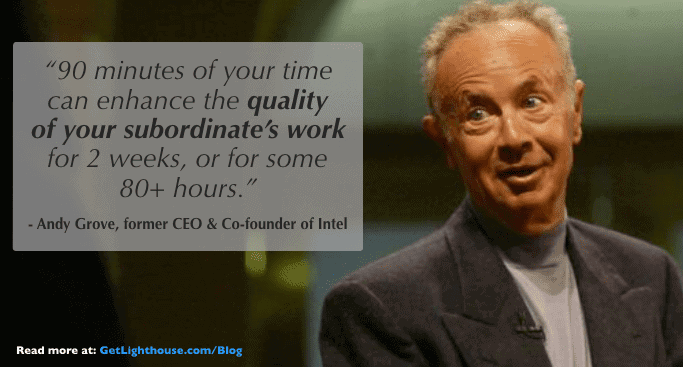
Where feedback really belongs: Weekly 1 on 1s.
If an annual performance appraisal is too infrequent of feedback, and real time feedback is way too much, too soon, then the happy medium is a regular meeting devoted to and focused on your team member.
Enter the 1 on 1 meeting.
If you're unfamiliar with 1 on 1s, they're a meeting where you set aside 30-60 minutes every week or two to meet with each person on your team. They cover a variety of topics that are focused on the team member you're meeting with.
1 on 1s provide a guaranteed time on your calendar to cover all the things you "mean to get around to." Because of their structure, they have quite a few advantages over real time feedback:
- Easy habit to keep: By scheduling a recurring meeting on your calendar, you always know when you'll be talking again. Anticipation allows for you and your team member to be prepared.
- Plenty of time to talk: With 30-60 minutes, you have the opportunity to really dig into issues: hear their side of the story, share examples, and talk next steps all at once. No more drive-bys.
- Strengthen relationships: With a meeting focused on them, you have the chance to build stronger rapport and trust. This will then make them more receptive to your feedback.
- Read body language: You see their face in a 1 on 1 (in person or on video), which allows you to pick up on non-verbal cues. These can hint at other issues, or help you tell if they really understand your feedback.
- Clear future progress: Your next 1 on 1 on the calendar marks a clear time when you'll talk about this again. You can ensure progress is made by checking in about it again next meeting.
1 on 1s can cover a variety of different topics, and feedback is one of the best ways to make good use of them. They're the perfect balance between giving more feedback, and making that feedback effective. To get the most out of them, check our one on one meeting template.
What if I have feedback for a peer?
While most 1 on 1s are between a manager and their team members, that's not the only kind. You can have a peer 1 on 1 with any colleague you work with regularly.
Peer 1 on 1s are a great time to share feedback and discuss how you can work better together. This can be a colleague on your team, or someone you collaborate with regularly (like design & engineering, or customer success & sales).
Just like a manager would take the time to build examples of a recurring issue, doing the same with a peer can help them understand why a piece of feedback is so important to you.

Find your happy medium.
Feedback is an issue on the mind of many leaders today as employees demand more of it. The options range from bold to status quo, but only one strikes just the right balance.
- Too Little: Annual performance reviews are too infrequent and often ineffective.
- Too Much: Real time feedback can be too much, too soon, on the wrong things.
- Just Right: 1 on 1 meetings give a regular time to go in depth on key feedback.
Once a year is clearly not often enough for feedback in our information laden era. Meanwhile, real time feedback is overdoing it like so many of our bad mobile habits. The 1 on 1 provides the "just right" balance to help managers and their teams more effectively discuss feedback.
Further Reading:
Want to learn more about the best, most effective ways to give feedback? Check out these posts below:
- 3 Simple Steps for How to Give Feedback that Improves your Team
- 6 Ways to Give Feedback that's Better than the Sh*t Sandwich
- How to Coach an Underperforming Employee
- Praise Guide: How to be more positive at work & give more praise
- How to Ask Your Boss for Feedback

What is real time feedback?
Real time feedback is where you use a system, like a mobile app, an email notification, etc to try to get more feedback right after an event, presentation, or meeting.
It is a *terrible* idea. Do not do it. Great managers know that feedback is best delivered in a live conversation, not an application over text.
By pausing and giving real coaching you will:
- See how your team member reacts to your feedback
- Have the chance to ask questions and ensure they understand it
- Provide more context, more clearly than you can in a short, written note
- Build more trust with your team member by showing feedback is worth a discussion, not a drive-by message
And most importantly, you'll know they've heard, understood, and will act on it, instead of potentially being misunderstood or not looked at at all in an real time feedback system.
Learn more about why real time feedback is a terrible idea and what to do instead here.
How do you implement continuous feedback?
Continuous feedback is a terrible idea and hurts your team. Nothing good is achieved by doing so.
With continuous feedback using a real time feedback tool, you:
- Turn quality feedback into a drive-by, one-way note
- Have no idea if they understood your feedback
- Get little distinction between a big problem and a minor one
- Have no reason to believe they'll change or get better.
Instead, you should pause and give real coaching in your 1 on 1s, where you can properly prepare, allow you both to ask questions, make sure they understand you, and talk together about next steps for improvement.
Learn more about why continuous feedback is a terrible idea and what to do instead here.




